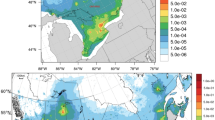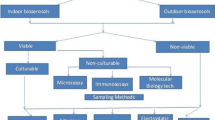Abstract
This article reviews the health effects of trace elements carried in natural dusts of geologic or geochemical origin. The sources of these dusts are diverse, including volcanoes, dust storms, long-range transport of desert dust, and displacement through natural processes such as landslides and earthquakes. The primary focus is dust exposures affecting communities rather than occupational groups (which have been comprehensively explored in other publications). The principal elements and compounds reviewed are trace metals (including As, Hg, Cd, and Fe), radioactive elements, fluoride, silicates, natural asbestiform compounds, and alkali salts. The pathways by which such agents affect human populations are explored, including carriage through water, air, soil, and the food chain. The mechanisms of biotoxicity and the acute and chronic consequences on health associated with these elements are described. The discussion explores problems inferring risk and disease causation from natural dust exposures using standard epidemiological indicators, particularly for chronic outcomes, and will argue for the importance of the ecological perspective in assessing pathogenesis. The authors stress the global scale of the problem, which remains underevaluated and underreported in terms of health implications.
Similar content being viewed by others
References
C. Moulin, C. E. Lambert, F. Dulac, and U. Dayan, Control of atmospheric export of dust from North Africa by the North Atlantic Oscillation, Nature 387, 691–694 (1997).
D. W. Griffin, C. A. Kellogg, and E. A. Shinn, Dust in the wind: long range transport of dust in the atmosphere and its implications for global public and ecosystem health, Global Change Hum Health 2, 20–33 (2001).
S. Rutherford, E. Clark, G. McTainsh, et al., Characteristics of rural dusts events shown to impact on asthma severity in Brisbane, Australia, Int. J. Metereol. 42, 217–225 (1999).
J. M. Prospero, Long-range transport of mineral dust in the global atmosphere: impact of African dust on the environment of the southeastern United States, Proc. Natl. Acad. Sci. USA 96(7), 3396–3403 (1999).
P. F. Holt, Inhaled Dust and Disease, Wiley, Chichester (1987).
A. J. Ridgwell, Dust in the Earth system: the biogeochemical linking of land, air and sea, Phil. Trans. R. Soc. London, A 360(1801), 2905–2924 (2002).
F. Grousset, P. Ginoux, A. Bory, and P. Biscaye, Case study of a Chinese dust plume reaching the French Alps, Geophys. Res. Lett. 30(6), 1277 (2003).
S. Moune, P. J. Gauthier, S. Gislason, et al., Trace elements mobility during degassing processes at Hekla (Iceland) and Masaya (Nicaragua) volcanoes, Geophys. Res. Abstr. 5, 3982 (2003).
D. Gillette, Soil derived dust as a source of silica: aerosol properties, emissions, deposition, and transport, J. Expo. Anal. Environ. Epidemiol. 7(3), 303–311 (1997).
R. J. van Klaveren and B. Nemery, Role of reactive oxygen species in occupational and environmental obstructive pulmonary diseases, Curr. Opin. Pulmonary Med. 5(2), 118–123 (1999).
C. J. Horwell, I. Fenoglio, K. Vala Ragnarsdottir, et al., Surface reactivity of volcanic ash from the eruption of Soufriere Hills volcano, Montserrat, West Indies with implications for health hazards, Environ. Res. 93(2), 202–215 (2003).
B. Melloni, A. Vergnenegre, P. Lagrange, and F. Bonnaud, Household radon exposure, Rev. Malad. Respir. 17(6), 1061–1071 (2000).
S. R. Gomez, R. A. Parker, J. A. Dosman, et al., Respiratory health effects of alkali dust in residents near desiccated Old Wives Lake, Arch. Environ. Health 47(5), 364–369 (1992).
P. Westerholm, Silicosis. Observations on a case register. Scand. J. Work Environ. Health 6(Suppl. 2), 1–86 (1980).
A. Ferrera and G. Faraone, Morphology and pathogenesis of pumice pneumoconiosis, Riv. Infort. Malattic. Prof. 40, 453 (1953).
A. Searl, A. Nicholl, P. J. Baxter, Assessment of the exposure of islanders to ash from the Soufriere Hills volcano, Montserrat, British West Indies, Occup. Environ. Med. 9(8), 523–531 (2002).
T. Norboo, P. T. Angchuk, M. Yahya, et al., Silicosis in a Himalayan village population: role of environmental dust. Thorax 46(5), 341–343 (1991).
H. N. Saiyed, Y. K. Sharma, H. G. Sadhu, et al., Non-occupational pneumonconiosis at high altitude villages in central Ladahk. Br. J. Ind. Med. 48(12), 825–829 (1991).
P. Kelleher, K. Pacheco, et al., Inorganic dust pneumonias: the metal-related parenchymal disorders, Environ. Health Perspect. 108(Suppl. 4), 685–696 (2000).
L. S. Newman, Metals, in Occupational and Environmental Respiratory Disease, P. Harber, M. B. Schenker, and J. R. Blames, eds., Mosby, St. Louis, MO (1996).
R. Avila, Epidemiologic aspects of suberosis and vineyard sprayer's lung, Bronchopneumologie 20, 50–60 (1980).
L. S. Newman, K. Kreiss, T. E. King, Jr., et al., Pathologic and immunologic altercation in early stages beryllium disease: re-examination of disease definition and natural history. Am. Rev. Respir. Dis. 139, 1479–1486 (1989).
A. Funahashi, D. P. Schlueter, K. Pintar, et al., Welder's pneumoconiosis: tissue elemental microanalysis by energy dispersive x-ray analysis, Br. J. Ind. Med. 5, 14–18 (1988).
E. S. Gurzau, C. Neagu, E. A. Gurzau, Essential metals—case study on iron. Ecotoxicol Environ. Safety 56(1), 190–200 (2003).
I. Baris, L. Simanato, M. Artvinlu, et al., Epidemiological and environmental evidence of the health effects of exposure to erionite fibers; a four-year study in the Cappadocian region of Turkey, Int. J. Cancer 39, 10–17 (1987).
G. Hillerdal, The pathogenesis of pleural plaques and pulmonary asbestosis: possibilities and impossibilities, Eur. J. Respir. Dis. 61, 129–138 (1980).
M. Neuberger, P. Ambrosch, and M. Kundi, Prevention of occupational cancer such as in the asbestos cement industry, Zentbl. Bakt. I Abt. Orig. B 181, 81–86 (1985).
M. Germine, Asbestos in play sand, New Engl. J. Med. 315, 89 (1986).
T. Burikov, L. Michaelova, Uber den Sepiolitgehalt des Bodens in Gebieten mit endmischen pleuraverkalkagungen, Int. Arch. Arbmed. 29, 95–101 (1972).
V. Rapisarda, M. Amati, S. Coloccini, et al. The in vitro release of hydroxyl radicals from dust containing fluoro-edenite fibers identified in the volcanic rocks of Biancavilla (eastern Sicily), Med. Lavoro 94(2), 200–206 (2003).
P. Grandjean, O. Andersen, and G. D. Nielsen, Carcinogenicity of occupational nickel exposures: an evaluation of the epidemiologic evidence, Am. J. Ind. Med. 13, 193–209 (1988).
International Agency for Research on Cancer (IARC), Evaluation of Carcinogenic Risk of Chemicals to Man, Volume 1, IARC, Lyon (1972).
H. E. Stockinger, A review of world literature finds iron oxide noncarcinogenic, Am. Ind. Hyg. Assoc. J. 45, 127–133 (1984).
I. Ebihara and M. Kawami, Mineral dust exposure and systemic diseases, J. Environ. Pathol. Toxicol. Oncol. 19(1–2), 109–127 (2000).
J. Augustin and R. Zejda, Cancer incidence and geochemical factors in the environment, Sci. Total Environ. 106(1–2), 155–163 (1991).
J. A. Centeno, F. G. Mullick, P. B. Tchounwou, et al., Environmental pathology and medical geology, in Medical Geology, O. Selinus, ed., Academic, London (2004).
T. Watanabe, T. Kondo, S. Asanuma, et al., Endemic fluorosis in southern China: radiological findings, Nippon Igaku Hoshasen Gakkai Zasshi (Nippon Acta Radiol.) 57(7), 425–426 (1997).
Y. Haikel, J. C. Voegel, and R. M. Frank, Fluoride content of water, dust, soils and cereals in the endemic dental fluorosis area of Khouribga (Morocco), Arch. Oral Biol. 31(5), 279–286 (1986).
S. J. Cronin, M. J. Hedley, V. E. Neall, et al., Agronomic impact of tephra fallout from the 1995 and 1996 Ruapehu volcano eruptions, New Zealand, Environ. Geol. 34(1), 21–30 (1998).
G. Yang, K. Ge, J. Chen, and X. Chen, Selenium-related endemic diseases and the daily nutritional requirements of humans, World Rev. Nutr. Diet 55, 98–152 (1988).
P. Weinstein and A. Cook, Volcanic emissions and health, in Medical Geology, O. Selinus, ed., Academic, London (2004).
S. J. Cronin and D. S. Sharp, Environmental impacts on health from continuous volcanic activity at Yasur (Tanna) and Ambrym, Vanuatu, Int. J. Environ. Health Res. 12(2), 109–123 (2002).
V. Bencko and J. Vostal, Air pollution by solid particles and public health: when can we conclude on causality? Central Eur. J. Public Health 7(2), 63–66 (1999).
E. Derbyshire, Natural dust and pneumoconiosis in High Asia, in Geology and Health: Closing the Gap, H. C. W. Skinner and A. R. Berger, eds., Oxford University Press, New York (2003).
J. Douwes, P. Thorne, N. E. Pearce, et al., Bioaerosol health effects and exposure assessment: Progress and prospects, Ann. Occup. Hyg. 47, 187–200 (2003).
J. L. Aron and J. Patz, Ecosystem Change and Public Health: A Global Perspective, John Hopkins University Press, Baltimore, MD (2001).
Author information
Authors and Affiliations
Rights and permissions
About this article
Cite this article
Cook, A.G., Weinstein, P. & Centeno, J.A. Health effects of natural dust. Biol Trace Elem Res 103, 1–15 (2005). https://doi.org/10.1385/BTER:103:1:001
Received:
Accepted:
Issue Date:
DOI: https://doi.org/10.1385/BTER:103:1:001




